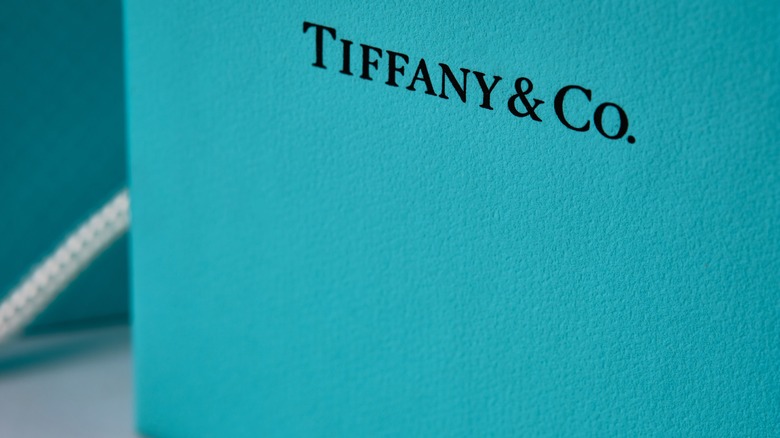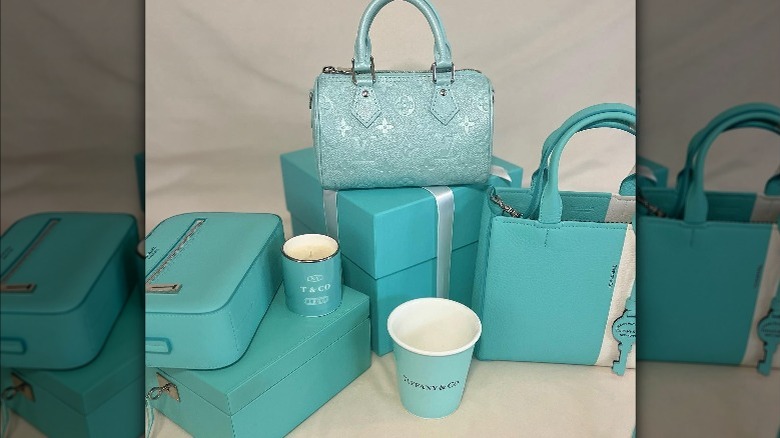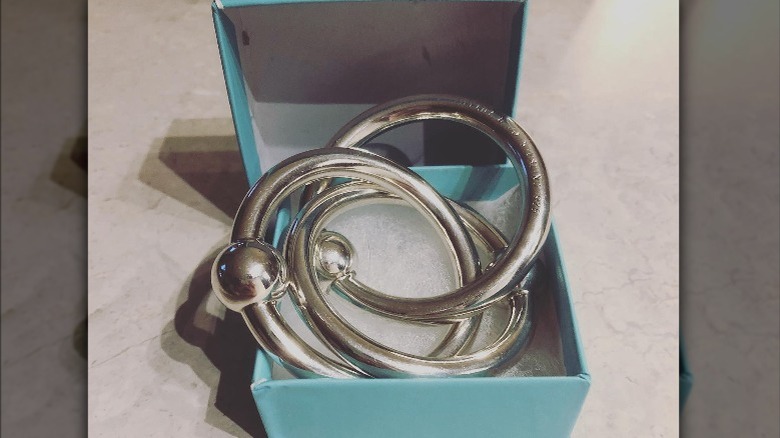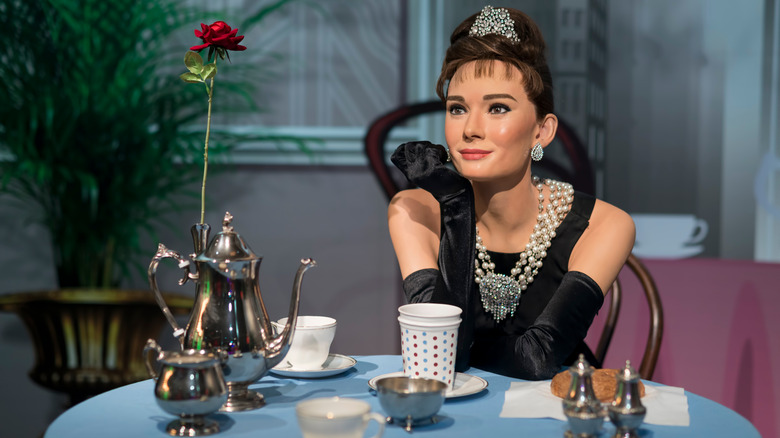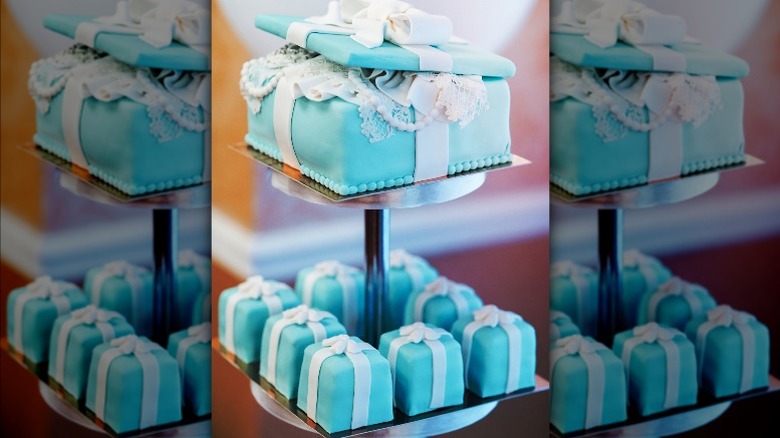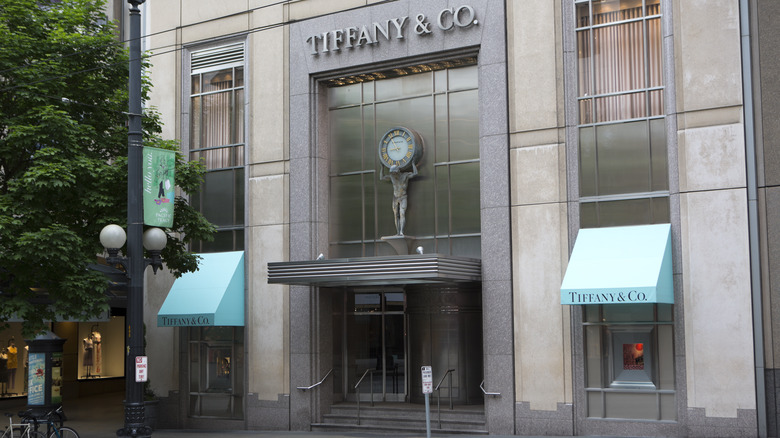The History Of Tiffany Blue, The Most Iconic Color In Fashion
It has appeared in movies, television shows, on the covers of books, in titles of projects, and in the pockets of nervous lovers about to ask those famous four words — "Will you marry me?" — which almost feel as if they were invented by the small mint-hued box itself. That small blue box is the brainchild of a creator who knew how to craft both jewelry and color. Tiffany blue has existed for fewer than 200 years but has become the most iconic shade on the color wheel in documented human history. Synonymous with the line of luxury jewelry, the greenish-blue hue did, in fact, begin with the origins of the namesake brand when jewelry genius Charles Lewis Tiffany, a.k.a. the founder of Tiffany & Co., mixed a few colors together and created the most famous tint to ever exist approximately eight years after launching the now globally-renowned company in 1837.
It's unknown why the innovative jeweler chose the color that's now synonymously intertwined with the brand, often reaching beyond the store to engagements and love stories themselves. However, there is speculation as to the significance of turquoise jewelry gifted within bridal circles during the Victorian era when the aqua-toned stone was a rarity and considered luxury in itself, thus embodying the premise of Tiffany & Co. during its founding era. Queen Victoria had significant sway over romantic traditions which continue today, with Tiffany blue leading these timeless trends.
Pantone 1837 is a worldwide sensation
Despite its launch in the mid-19th century at the peak of the Victorian era, the shade of Tiffany's iconic mint-blue hue wasn't officially recognized by color powerhouse Pantone until 2001. The company known for its standardized system of matching colors for congruency of palettes, particularly for printing, the timeless Tiffany blue shade was given the official designation of 1837 Blue, though it has colloquially come to be known as Pantone 1837, or simply Tiffany blue.
When Pantone identified and classified the shade, the commanders of color shared that the color's name was to be 1837 Blue rather than its colloquial name of Tiffany blue, prominently paying homage to the year of Charles Lewis Tiffany's founding of the jewelry house and his accompanying Blue Book publication, the annual catalog of offerings from the boutique brand published each year. The respect for the brand's history felt more significant to the timelessness and foundational meaning of the brand itself, rather than the vogue interpretations of the pigment.
In studying the shade, chief color experts said their panel defined the color as being provocative of feelings of vibrant seascapes, feelings of freshness and new beginnings. In their view, the shade possessed the talent to instantly produce associations of couture design and exclusivity, thus epitomizing luxury with never-ending exhilarating escapes inviting viewers to swim in the luminously liquid aesthetic of 1837 Blue. The color even inspired Hailey Bieber's spring 2023 manicure.
Significant business savvy secured the shade
Following its introduction decorating fair booths to display jewelry, which young Charles Lewis Tiffany rented at the onset of his career, the fresh, playful pigment which became Tiffany blue cultivated influence so steadily it became intrinsically intertwined as purely representing the retailer in a way no other entity could replicate despite trying.
Over decades, Tiffany blue's fluidity of nicknames has been as flexible and versatile, yet timeless and classic, as the shade's single symbolism. Pantone officially coins the hue 1837 Blue, while Tiffany & Co. has used other references of "robin's-egg blue" and "forget-me-not blue" in accordance with the emblematic meaning of the bird's soon-to-be hatchling and the flower's romantic designation as representing the truest love of all, a romance not soon to be forgotten.
The business savvy of the pet names which Tiffany & Co. has incorporated into its marketing is noticeable only to those who realize the strategy of the associations, with an impending hatch of a pastel bird's egg fitting with the jewelry brand's notable sales of sterling silver rattles and fine pieces representing the birth of a child and floral inferences of ever-lasting, all-powerful love which can defeat all odds. Between these two of the biggest events rattling — pun intended — human emotions during a person's lifetime, Tiffany & Co. has been commended for its ingenious ability to invite people into its world of luxury with the subtlest of symbols.
A color collectively captivates the dreams of generations
Without any doubt, the shade of Tiffany blue and its cultural, social, and even political significance have been more prominent as a single hue than any other color selection. The significance of the shade isn't simply in its global recognition but is firmly rooted in its ability to derive the aspirations, dreams, and romantic moments of generations. From the novella and film of the same name, Audrey Hepburn elevated the boutique jeweler and the color of Tiffany blue to new heights despite the most memorable photo of Hepburn in the film "Breakfast at Tiffany's" showing her wearing an all-black ensemble with white pearls. For a shade like Tiffany blue to take the spotlight in a frame where the iconic color is not even center stage, the prevalence of Tiffany blue's pigment is particularly profound in its ability to captivate.
As reported by Tatler Asia, research shows that when men and women catch a glimpse of a Tiffany blue trademark box, their heart rates respectively increase by 20% and 22% in relation to the significance of what the small, robin's-egg-tinted box epitomizes. When Charles Lewis Tiffany spearheaded the company, he insisted that the tiny blue boxes could only be sold with jewelry inside of them, or they remained the one item in the store which couldn't be purchased.
The color celebrates moments beyond proposals
Tiffany & Co. is best known for its engagement rings sold in hallmark Pantone 1837 Blue boxes. However, the company wouldn't be nearly as successful today if the shade didn't surpass the engagement of betrothed couples and follow them with influence throughout their lifetimes, which is exactly what's happened throughout both the company and the color's relevant existence. In 2018, the retailer even took over public transportation within New York City, thus effectively taking over the city itself, with a collaboration that saw the epochal yellow taxi cabs of the city turn Tiffany blue. The Big Apple quite literally became juxtaposed with the luxurious exclusivity of Tiffany & Co. in a takeover termed by Reed Krakoff, the company's Chief Artistic Officer, as a tribute to Audrey Hepburn's character in "Breakfast at Tiffany's" and her pursuit to belong to the luxurious lifestyle as she stood in front of the storefront's glass with tinted reflections of 1837 Blue shining through. The pop culture icon is just one to look to for style inspiration.
Between Tiffany-themed events and scenic decor inspired by the iconic film, the common thread amongst popular events such as bachelorette parties, bridal showers, baby showers, and Sweet 16 celebrations is the color 1837 Blue. Box-shaped pastries and table decor emblazon galas, fundraisers, and school dances spirited with the distinctive color, showing that proposals are only one facet of Pantone 1837.
Tiffany blue is a timeless link to the past while forging future influence
Tiffany & Co. is considered a timeless brand of unbreakable stature, though the color of Tiffany blue is inarguably far more recognizable than any particular jewelry piece the couture brand offers. With one shade of minty-blue, stories of decades, eras, and centuries are told while plans for the future are laid out with Pantone 1837 in mind. Per Tiffany & Co.'s own authored legacy page on the company's website, the ethos of the brand is described as a spirited journey from traditional European fashion to the making of American culture in the mid-19th century. The company and, thus, the color was founded on a fusion of European and American fashion with the understanding that Charles Lewis Tiffany selected the shade of blue between creamy hues of aqua and turquoise because it aligned with the jewelry brand's mission to sell bridal jewelry, particularly engagement rings, to soon-to-be betrothed couples of the Victorian era beginning upon the brand's 1837 launch.
In keeping with the times of the Victorian era, fashionable women followed the lead of Queen Victoria in desiring turquoise pieces for their wedding days or as betrothal gifts, much like the 1837 Blue boxes today reveal sparkling diamond engagement rings. Tiffany himself drew from relevant artistic periods such as Art Nouveau to maintain the brand's name with merely subtle tweaks. But, despite the changes within the company, Tiffany blue has remained constant and iconic.
